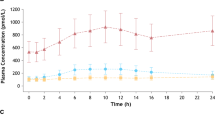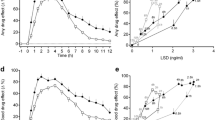Summary
The tolerability, pharmacokinetics and pharmacodynamics of adinazolam and N-desmethyladinazolam (NDMAD) were assessed following intravenous infusions of 5, 10, 15, and 20 mg adinazolam mesylate, 10, 20, 30 and 40 mg NDMAD mesylate, and placebo. Six subjects per dose level received treatments in a double-blind crossover design.
No clinically significant changes were seen in blood pressure, pulse, respiration, or clinical laboratory parameters. Untoward effects typical of benzodiazepines were observed almost exclusively after NDMAD administration. Adinazolam and NDMAD pharmacokinetics were dose-independent. NDMAD clearance was 50% of the value for adinazolam. Adinazolam and NDMAD administrations increased uric acid clearance and decreased plasma uric acid. Adinazolam administration had no significant effect on psychomotor performance. NDMAD administration produced dose related decreases in performance; 286 ng/ml NDMAD produced a 50% decrease in DSST.
These results confirm that adinazolam and NDMAD both produce uricosuria and definitively show that adinazolam is devoid of benzodiazepine-like effects at therapeutic concentrations; NDMAD mediates these effects. Uricosuric activity is present for both compounds, but the relative potencies are still unknown.
Similar content being viewed by others
References
Amsterdam JD, Kaplan M, Potter L, Bloom L, Rickels K (1986) Adinazolam, a new triazolobenzodiazepine, and imipramine in the treatment of major depressive disorder. Psychopharmacology 88: 484–488
Dunner D, Myers J, Khan A, Avery D, Ishiki D, Pyke R (1987) Adinazolam-a new antidepressant: findings of a placebo-controlled, double-blind study in outpatients with major depression. J Clin Psychopharmacol 7: 170–172
Cohn JB, Pyke PE, Wilcox CS (1988) Adinazolam mesylate and placebo in depressed outpatients: a 6-week, double-blind comparison. J Clin Psychiatry 49: 1427
Pyke RE, Greenberg HS (1989) Double-blind comparison of alprazolam and adinazolam for panic and phobic disorders. J Clin Psychopharmacol 9: 15–21
Sheehan DV, Raj AB, Harnett-Sheehan K, Soto S, Lewis CP (1990) Adinazolam sustained release formulation in the treatment of generalized anxiety disorder. J Anx Disorders 4: 239–246
Peng GW, Todd WM, Rykert UM, Stryd RP, Pyke RE (1986) Dose proportionality of adinazolam mesylate (DERACYN®). Pharm Res 3 [Suppl]: 108s
Fleishaker JC, Phillips JP (1989) Adinazolam pharmacokinetics and behavioral effects following administration of 20–60 mg oral doses of its mesylate salt in healthy volunteers. Psychopharmacology 99: 34–39
Fleishaker JC, Friedman H, Pollock SR, Smith RC (1990) Clinical pharmacology of adinazolam and N-desmethyladinazolam mesylate after single oral doses of each compound in healthy volunteers. Clin Pharmacol Ther 48: 652–664
Sheridan AQ, Guth D, Neff GI, Linet OI (1989) The antihyperuricemic proporties of a triazolobenzodiazepine-DERACYN® tablets. J Clin Pharmacol 29: 838
Stryd RP, Kaiser DG, Smith TC, Bohn DF, Peng GW, Bryan WJ, Sheridan AQ, VanGiessen GJ (1990) Pharmacokinetics of adinazolam (AD) and N-demethyladinazolam (DMAD) after intravenous single doses of adinazolam mesylate (ADM) in healthy humans. Pharm Res 7 [Suppl]: S210
Fleishaker JC, Friedman H, Pollock SR (1991) Extent and variability of the first-pass elimination of adinazolam mesylate in healthy male volunteers. Pharm Res 8: 162–167
Fleishaker JC, Phillips JP, Smith TC, Smith RB (1989) Multiple dose pharmacokinetics and pharmacodynamics of adinazolam in elderly subjects. Pharm Res 6: 379–386
Tietz NW (1976) Fundamentals of clinical chemistry. Saunders, Philadelphia
Wechsler D (1955) A manual for the Wechsler adult intelligence scale. Psychological Corporation, New York
Smith RB, Kroboth PD (1987) Influence of dosing regimen on alprazolam and metabolite serum concentrations and tolerance to sedative and psychomotor effects. Psychopharmacology 93: 105–112
Fleishaker JC, Smith TC, Friedman H, Phillips JP (1991) N-desmethyladinazolam pharmacokinetics and behavioral effects following administration of 10 to 50 mg oral doses in healthy volunteers. Psychopharmacology 105: 181–185
Gibaldi M, Perrier D (1982) Pharmacokinetics, 2nd ed. Dekker, New York
SAS Institute, Inc. SAS User's Guide: Statistics. Version 5 Edition. SAS Institute, Inc., Cary, NC
Hulhoven R, Desager JP, Cox S, Harvengt C (1988) Influence of repeated administration of cimetidine on the pharmacokinetics and pharmacodynamics of adinazolam in healthy subjects. Eur J Clin Pharmacol 35: 59–64
Kroboth PD, Smith RB, Erb RJ (1988) Tolerance to alprazolam after intravenous bolus and continuous infusion: psychomotor and EEG effects. Clin Pharmacol Ther 43: 270–277
Author information
Authors and Affiliations
Rights and permissions
About this article
Cite this article
Fleishaker, J.C., Hulst, L.K., Smith, T.C. et al. Clinical pharmacology of adinazolam and N-desmethyladinazolam mesylate following single intravenous infusions of each compound in healthy volunteers. Eur J Clin Pharmacol 42, 287–294 (1992). https://doi.org/10.1007/BF00266350
Received:
Accepted:
Issue Date:
DOI: https://doi.org/10.1007/BF00266350




